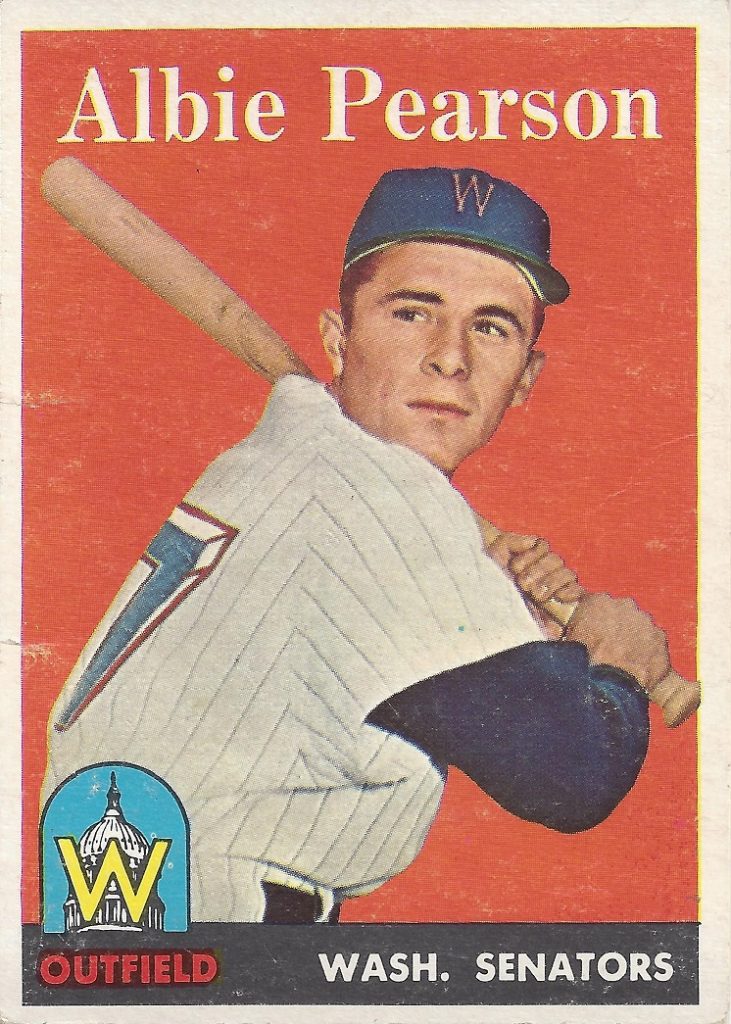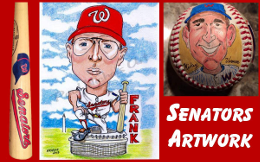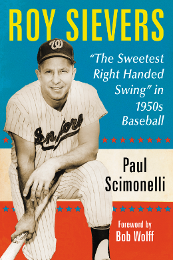By Jeff Stuart
When Albie Pearson won the Rookie of the Year Award in 1958 and Bob Allison followed suit in 1959, Washington became the first American League team to have players win the award in back to back years. It was not until 30 years later that another AL team accomplished the feat. Jose Canseco, Mark McQwire, and Walt Weiss Oakland A’s won the award in 1986, ‘87, and ‘88.
Pearson was traded, along with first baseman Norm Zauchin, to Washington by Boston for Pete Runnels before the start of the 1958 season. Although signed by the Red Sox as a pitcher, Pearson was converted to the outfield. And after getting 8 hits in his first two games with San Jose of the California League, he did little pitching during his minor league career.
Senator’s owner Calvin Griffith was impressed with Pearson in spring training. “We’ve been searching for a drawing card for years. And I have a hunch we’ll have two of them this season in Sievers and Pearson.” Sievers had won the AL ROY award in 1949 with the St. Louis Browns.
Pearson was baseballs smallest competitor at 5’4″and 160 pounds. A left handed batter, he hit .275 in 1958 with 3 homeruns and 25 doubles. He scored 63 runs. In 146 games he had 146 hits and 190 total bases. Defensively, the 23 year-old center fielder was excellent.
Albie collected 14 of 24 votes in collecting the ’58 ROY award. Yankee reliever Ryne Duren got 7 votes and right hander Gary Bell of Cleveland got 3. Three baseball writers in each of the 8 American League cities cast votes.
But when he did not get a raise prior to the 1959 season, he held out. “I’ve got a wife and three kids,” he told the Washington Post. “I’m truthful about saying I need the money. I can’t get along on what I made last year. I’ve got to make it while I am young and have the potential. What’s the use of being in baseball otherwise?” Pearson Played for Havana in the Cuban Winter League in the winter of 1958-59. He hit just .258. “But it’s a pitchers league,” he said. “And I was the seventh best batter in the league if that meant anything. Minnie Minoso of Cleveland only hit .265. It was tough for a left-handed hitter because of the background in the parks we played in. I think my fielding improved a lot and I learned a lot. Am I tired? I sure am. Just consider I have played 230 to 240 games without a let up. I’m only a little guy but this would be enough to kill a giant.”
Pearson’s spring training hold out gave Allison his chance in center. And little Albie was traded to Baltimore on May 26, for outfielder Lenny Green. In Baltimore the sophomore jinx set in. Albie hit just .216 with the Orioles in ’59. Pearson was selected by the new Los Angeles Angels in the expansion draft in October 1960.
He scored the franchise’s first run on opening day in 1961. He hit .288 with 7 home runs, 41 RBI, and 92 runs for the season. His best season was 1963, when he posted career-highs in batting average (.305), hits (173), runs batted in (47), stolen bases (17) and games played (160). He finished fourth in the AL batting crown race behind Carl Yastrzemski (.321), Al Kaline (.312) and Rich Rollins (.307).
Pearson had only 28 lifetime homers, but nine of them were in an Angel uniform against the Yankees. Albie had the honor of escorting Marilyn Munroe from the dugout to home plate at Yankee Stadium where she made her final public appearance on her 36th birthday, June 1st 1962. “There was some sort of charity function at the stadium. So I go out to the dugout and I looked at the most famous yet loneliest person I ever saw in my life,” Pearson told the San Bernardino Sun. “She was a beautiful shell. I expected her to come out flashing a big smile, and I got this sad sober look. But once she hit that top step of the dugout she became Marilyn Monroe the movie star, smiling and waving.”
Because of recurring back problems, Pearson retired after the 1966 season. In his nine-year career major league career, he had a .270 batting average.
Pearson, now 80, is an ordained minister living in California. His focus is on abandoned and neglected children. He helped set up out reaches in Ecuador and Zambia. As of 2011 Pearson and his wife Helen had five daughters, 17 grandchildren, and 16 great-grandchildren.
The 6’3″, 205 pound Allison was considerably larger than Pearson. A football and baseball star at the University of Kansas was signed by Washington in 1955.
He cost the Senators, 4000 dollars. New York offered Allison the same money. But Nats scout Ray Baker offered him quicker entry into the Major Leagues.
Allison became part of a 1959 Washington lineup that also featured sluggers Jim Lemon, Harmon Killebrew and Roy Sievers. Killebrew and Allison were technically both rookies though Harmon, a bonus baby, had played some games with the Senators in each of 5 previous seasons, topping out at 44 in 1956. Griffith wanted both in the lineup and even moved in the fences at Griffith Stadium to accommodate his young power hitters.
On April 23rd, 1959, Post Columnist Shirley Povich wrote, “The triumphs of the Nats have been few since the opening day game. But a continual joy has been the deeds of Bob Allison who is installing himself solidly in the affections of Griffith Stadium fans and winning the deep friendship of Manager Cookie Lavagetto too. Young Mr. Allison has been demonstrating he is an excellent ballplayer. His throwing arm evokes gasps of admiration. He is the largest man on the Washington club, bigger by 10 pounds than Sievers. In the past Washington has tried to bring many kids along too fast. They left Allison in the minors for 4 years and he improved successfully until he became, it is now strongly suspected, a full ballplayer.” “He is realizing that he e belongs in the majors and is now looking tough to pitchers,” said Lavagetto. Washington trainer Doc Lentz proclaimed Allison the most perfect physical specimen he had seen in 30 years of training.
When Bob hit a grand slam off Chicago’s Early Wynn on May 6th, in Chicago, it gave the Nats a 6-4 win and 7-2 western road trip, their most successful since a 9-1 trip to the west in 1949.
In 1959 Allison hit .261 and had 85 runs batted in. His 30 homers were within one of Ted Williams’ record of 31 homers by a rookie set in 1939. Oddly, in 4 years in the minors he hit only a total of 28 homeruns.
In the rookie of the year voting, Allison got 18 of the 24 votes needed, 4 more than Pearson the year before. There were 5 votes for Cleveland’s Jim Perry and 1 for Kansas City outfielder Russ Snyder. Bob stole 13 bases and led the league with 9 triples. He was second in batting and in walks. He hit 29 of his 30 homers against right handed pitching. But he homered off 25 different pitchers and 21 times against first division teams. Not especially fast, he was a good base runner, hitting a lot of doubles and triples. Defensively, he got a good read on fly balls.
Primarily a right fielder, he played all the three outfield positions. He finished in the top 5 in the American League in outfield assists 3times. Like Pearson before him, Allison played winter ball in Cuba in the off season after his rookie year. But he quit in mid- season because he wanted to spend with his family.
Unlike Pearson, Allison got a raise of $5000 after his great debut. He signed in 1960 for 14000. “The sophomore jinx business is silly,” he told the Post. “I don’t see why I can’t do as well as last year. I know I only hit .261 and I know I can do better. I have a lot to learn. But I picked up invaluable experience last season. It stands to reason that I should do better. I’m proud of the fact that I’ve improved every year I have been in baseball.”
But the rookie jinx did affect him. In 1960 he hit only .251 with 15 homers with 69 RBI. But he did hit 30 doubles. “Allison laments the absence of Sievers (Traded to Chicago for Earl Battey) who was his hitting coach,” said Povich.
Unfortunately for Senators fans, Allison’s stay in Washington was brief. The franchise relocated to Minneapolis after the 1960 season. “I’ve grown attached to Washington and I’d like to stay here,” he said at the time. “I am unhappy and sad to think the Senators are moving to Minneapolis. I leased an apartment in Silver Spring. Maybe in this new disaster plan they are talking about to stock the new Washington franchise, I could be retained here. I would certainly like to be. I hope it is not impossible.” Allison adapted to Minnesota though. He even wrote a baseball column while playing there that was published in over 400 weekly papers. And as a Twin, he earned the respect of his fellow big leaguers and was appointed as a player representative to a 4 man player pension fund committee consisting of 2 owners and two players.
In 13 seasons in the Majors, he was a two time All-Star. He played in the 1956 World Series and the 1969 and 1970 AL playoffs. He died in 1997 of ataxis, a neurological disorder that affects nerve cells in the brain.
More than 50 years later 20 year old Bryce Harper won the National League ROY award. He was 3 years younger than Pearson was in 58 and 4 years younger than Allison was in 59. He hit 22 homeruns, had a .270 batting average and 59 RBI in 139 games.








